 |
| Bhakra Dam: The Green Revolution's great
enabler |
1963
The Green Revolution
The Bhakra dam-enabled green revolution gave
India food security and broke the back of Malthusian fatalism.
So
many years on, it's easy to forget the thrill that gripped India
on October 22, 1963, when the Bhakra Dam was commissioned. It was
a winning moment-a moment of conquest. Conquest of hunger-or at
least the fatalism with which India's millions were thought to be
at the mercy of this scourge.
The Dam, built on the Sutlej river, was a key
enabler of the Green Revolution led by the legendary M.S. Swaminathan.
Back then, in 1967, India was nowhere close to food self-sufficiency,
and poor agricultural performance was often brushed off as some
kind of grim Malthusian inevitability. Population growth had to
outstrip food output, and population was the variable that had to
be controlled-fast.
Today, of course, scientific farming has got
the better of the Malthusian nightmare. From some 75 million tonnes
of foodgrain output, India managed to hit 131 million tonnes in
1978-79-through waste-free irrigation, better yielding grain varieties
and better farming techniques. Today, the figure nudges the 200-million
mark. "In countries where more than 50 per cent of the population
depends on agriculture," notes Swaminathan, currently Chairman,
M.S. Swaminathan Research Foundation, "agricultural progress
is the safety-net against hunger and poverty."
His next great hope: an eco-friendly Evergreen
Revolution. Today, the spirit of defying doomsayers continues, and
India can become a major food supplier to the world-if the WTO gives
the country a fair chance.
1970
Operation Flood
A marvel of rural networking and supply-chain
efficiency, it turned India milk sufficient.
 |
| The National Milk Grid: 9.3 million
dairy farmers strong by the end of the programme |
Operation flood
was India's first triumph of network management on such a vast scale.
Launched in 1970 with the redoubtable Dr Verghese Kurien at the
helm of the National Dairy Development Board (NDDB), the basic idea
was to organise Indian dairy farmers into self-managed village cooperatives,
made commercially viable by a larger programme to absorb excess
milk into a National Milk Grid, created to service consumers in
over 700 towns and cities.
Modern dairy methods, accompanied by efficient
milk-flow management, Kurien knew, could reduce seasonal supply
variation, stabilise milk prices and also ensure that the farmers
got their due.
The first challenge, as Dr Kurien recalls,
was getting management talent. "In 1965," he says, "I
approached J.R.D. Tata to supply me with six managers who could
work with me for a year, because I said that industrial development
can only proceed in India if it rests on a solid agricultural base.
But the Tatas fumbled the ball. So I had to set up the IRMA in 1979
in Anand, which produces 80 Kuriens a semester."
It took a few years, but when the ball was
set rolling, there was no looking back. As a direct result, India's
per capita milk consumption rose from 111-gm per day in 1973 to
202 gm per day in 1998. By 1994, India had moved from milk-deficient
status to milk surplus.
By the end of the programme, in 1996, the network
had nearly 9.3 million dairy farmers registered with some 75,000
local cooperatives, supplying milk to 170 milksheds.
1974
Bombay High
This offshore rig struck oil just a few
months after the 1973 oil shock.
It was a high,
undeniably. On February 19, 1974, the country's Oil & Natural
Gas Commission (ONGC) hit a major oil and gas field off the coast
of Bombay. Take a look at the date again. This was just six months
after the Oil Shock of 1973, with crude oil prices trebling to bloat
India's oil import bill. Bombay High was a grand relief, with Sagar
Samrat spurting out India's own black gold. The rig has drilled125
wells over the years. Till April 1998, the field had produced 2.4
billion barrels of oil and 177 billion cubic metres of gas.
1970s
TCS Exports Software
The business that was to change world
perceptions of Indian technical competence, and kick off the race
for software supremacy.
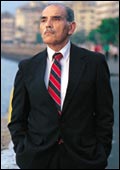 |
| F.C. Kohli: The visionary focussed on
software exports in the 70s |
People knew little
about computers, let alone software services, when Tata Consultancy
Services (TCS) began operations in 1968 under the leadership of
F.C. Kohli, a man aeons ahead of his time. In 1972, this low-profile
unit of Tata Sons got its first overseas order, from the City of
Detroit Police Department and then another...and another. Over the
1970s, TCS' exports grew...and grew.
Today, the world looks to India as a reliable
source of highly-skilled software services. Not just for one-off
task execution programmes, but increasingly also end-to-end solutions-which
require a conceptual level understanding of the client's competitive
edge. The brand 'Indian software' has been sold, and TCS gets much
of the credit for breaking perceptual barriers overseas.
TCS, now on the verge of becoming a billion-dollar
company, is busy extending itself across the globe. Says S. Ramadorai,
Managing Director, "You need to have reach as a global company...
reach to be close to the customers, reach to be visible, reach to
deliver solutions, reach to leverage the offshore capabilities,
reach to attract some talent within the local community." It's
a vision that has created an entire industry. An industry that's
ready to stand up and be counted as world-class.
1978
Going Global
AV Birla Group's palm oil refinery in
Malaysia topped world charts.
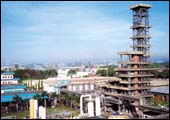 |
| Pan Century Edible Oils: Building on
a natural advantage |
Corporate India
was globalising before globalisation became a buzzword. In 1978,
the Aditya Vikram Birla group planted its flag in Malaysian soil-with
the setting up of Pan Century Edible Oils. Since then, it has become
the world's largest single-location palm oil refinery. The plant
currently processes over 1 million tonnes of palm oil.
Why Malaysia? Simple. The natural advantage
of raw material availability. The group's current chief, Kumar Mangalam
Birla, should be proud.
1983
Cricket World Cup
No abstract victory this; it was a collective
moment of obvious triumph. For millions together-live on TV.
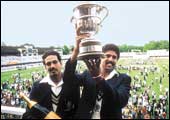 |
| India lifts the World Cup at Lord's: Winning
against impossible odds |
The pulse races,
the breath shortens, and the fist pounds the air. A reflex. A rush
of blood. A victory. June 25, 1983. A collapse of the last West
Indies wicket; and the World Cup in India's grasp.
Never had a team made the London bookies eat
their hats (along with their odds-billed at 66-to-1 against India)
with such joyous abandon. West Indies was the terror team of the
time, reigning World Champion ever since the Cup began-but a twist
here, some magic there, and India won!
Almost two decades later, the significance
of that 1983 victory at Lord's is still to fully sink in. And we're
not just talking about the mega-boost to the Indian morale. That
goes without saying.
"For the first time," says team captain
Kapil Dev, in retrospect, "cricket united the country."
It also gave the country a sense of global confidence. A certain
bounce in the stride.
Cricket used to be an Englishman's game, also
played by a few others as a colonial legacy in a few odd parts of
the world. Today, cricket is an Indian game, also played by its
originators on some cold faraway island. The game's centre of gravity
has shifted to India. Just look at the numbers. An overwhelming
share of the money the game attracts globally, is from here.
The 2003 World Cup, to begin soon in South
Africa, has three of the four main sponsors (Pepsi, LG, Hero Honda
and South African Airways) looking to the Indian market for returns
on their investment. That's how it is. Create a Great Eyeball Trap,
and the world beats a path to your door. Such is the game's appeal
that marketers wouldn't know what to do without it.
 |
| Deals on wheels: Cost-efficiency is
everything |
1986
Hero Becomes Number One
Low costs gave Hero volumes, and volumes,
low costs.
In 1986, hero cycles
became the world's largest maker of bicycles. The formula? High
volume, low costs. Today, it cranks out 19,000 cycles every day.
The group's JV with Honda has repeated the model for motorcycles,
selling over 1.5 million units a year. Pawan Munjal, Managing Director,
Hero Honda Motors, attributes the success to "our customer-centric
approach and efficient management of resources and skills".
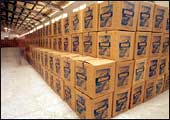 |
| Value-for-money: For 250 million customers |
1989
The World's Largest-Selling Soap
Nirma's yellow powder-a mass-market phenomenon.
In 1969, when Karsanbhai
Patel launched Nirma, he couldn't have imagined it would become
the world's highest-tonnage (500,000 tonnes in 1987-88) detergent
in just under 20 years. And it gave him, in his own words, "a
deep sense of satisfaction from the fact that value-for-money offerings
from Nirma could convert luxuries into necessities for the Indian
Common Consumer." Nirma still sells over 800,000 tonnes of
detergent every year.
1991
Licence Raj Dies
In a stroke, decades of misguided economy
policy were abandoned to allow market forces in.
 |
| Manmohan Singh: Defining India's new
tryst with destiny |
The euphoria in
jeejabhoy Towers, which houses the Bombay Stock Exchange, had to
be experienced to be believed. People were literally being swept
by waves of joyous heads thronging the building. The din was too
uproarious to hear anything the man on the TV screen was saying.
It didn't matter anymore. The deed had been done. The Licence Raj
had been pronounced dead.
The day was July 24, 1991, and the man on TV
was Manmohan Singh, the then Finance Minister. "India stands
at the crossroads. The decisions we take and do not take, at this
juncture, will determine the shape of things to come for quite some
time," the man had said, casting aside decades of misplaced
faith in the mixed economy, short-hand for a command economy with
a handful of privileged licence-holders. At long last, competition
had been allowed in, and the Iron Hand of the state had been replaced
as resource allocator-in-chief by the Invisible Hand of the market.
Yet, reforms remain incomplete. As one observer
put it, the early reforms were sneaked past the Indian electorate,
but now, the free market idea must be sold to the people.
1992
Reliance Raises Global Money
Reliance's GDR opened up the promise
of foreign capital for Indian business.
 |
| Dhirubhai Ambani: Global dreams realised |
In the isolated
old days, investors in Manhattan skyscrapers wouldn't have bothered
betting on an Indian business to save their nuts. India was simply
off their map. So it was a momentous occasion when, in May 1992,
Reliance Industries raised funds-in hard dollars, no less-from the
international capital market.
And these were not some foreign investors trying
to take control of a 'third world' bsuiness, but actual investors
counting on the Ambanis to enrich them. A global $150 million vote
of confidence, so to speak, in Reliance's quest for world-scale
capacities (in polypropylene, for example).
The instrument was the Global Depository Receipt
(GDR), which represents the dollar value of the firm's underlying
equity. Since then, some 60 Indian companies had raised over $6.5
billion via GDR issues. Foreign capital is now within reach-at last.
1996
India As A BPO Centre
GE picks India as its Business Process Outsourcing
(BPO) centre.
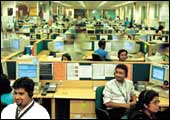 |
| The world's back-office: Near you |
It has become a
wave already. It was in 1996 that GE, scouting for a low-cost base
to source its back-office business processes to, zeroed in on Gurgaon,
a suburb of Delhi just South of the capital in Haryana. Recalls
Pramod Bhasin, President, GECIS: "When we started, we had no
set business models to follow, no prior experience... all we had
was a vision and a huge amount of enthusiasm and energy to make
it work."
From an employee base of 600, GE's call centre
now has more than 12,000 today, and the company's intense training
systems have spread far and wide-as more and more business process
outsourcing centres mushroom by the month. India is becoming the
world's back office.
1998
Sundaram Clayton Wins Deming Medal
The first-ever Indian firm to win the
world's most prestigious award for quality.
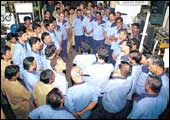 |
| Total quality: Means, not an end at
TVS Group's Sundaram Clayton |
For years, analysts
would groan about India's poor quality reputation, with the 'it's
ok' attitude as their prime suspect. And then, along came Sundaram
Clayton, and won the Deming Prize for quality. On November 14, 1998,
the company's CEO Venu Srinivasan received the prize instituted
in 1951 by the Union of Japanese Science and Engineering (JUSE)
in honour of the quality guru W. Edwards Deming. And from then on,
the country has been whinging less, and working more-towards quality.
Sundaram Clayton, part of the Chennai-based
TVS Group, makes air and vacuum braking products for vehicles, among
other things. Thanks to the rigour with which its brakes division
had applied systems of company-wide quality control (CWQC), it became
the first Indian company ever to bag the award. And the company
hasn't rested on its laurels. "Excellence is a moving target,"
says Srinivasan, "and when we received the Deming prize in
1998, we moved on-as this was the start of the TQM journey and not
the end... the prize is just a ticket to the journey." For
the record, in 2002, Sundaram Clayton won the Japan Quality Medal,
a honour reserved for the best of Deming awardees.
1999
Infy Lists On Nasdaq
For Infosys, raising foreign capital
was not the idea. By listing on Nasdaq, it got itself a currency
(stock) to hire top talent and make acquisitions across the world.
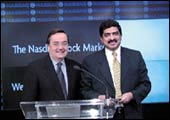 |
 |
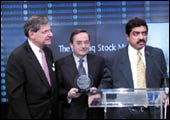
|
 |
| Infosys' now CEO Nandan Nilekani
(top, right) at NASDAQ: Infy goes down the wire |
It was another
day in cyberspace, with zillions of 0s and 1s zipping up and down
the information superhighway. But for India, March 11, 1999, was
not just another day in cyberspace. It was the day that somebody
sitting in some remote corner of the world could log on to his computer,
hit a few keys, and buy himself a part of India's premier software
exporter, Infosys Technologies.
That was the day that Infosys' share began
trading on America's premier online stock exchange, Nasdaq. The
event was beamed live from New York to giant video-screens on a
basketball court at the Infosys' Bangalore campus. "This is
a small step for Nasdaq but a giant leap for Infosys and the Indian
software industry," said Chairman N.R. Narayana Murthy from
New York. It was a rare moment of exultation for a man who is otherwise
given to understatement as his style.
Within two hours of active trading, the US-listed
Infy share touched $50, up $12.88 from the listing price of $34.
The share closed the trading day (!) at a healthy $46.88. The company
was pleased. But not for the reasons you might imagine.
At last, it had a 'currency' to recruit global
talent (via dollar stock ops) and make overseas acquisitions (via
all-stock deals). Just accessing funds, in itself, was not the idea.
Explains Nandan Nilekani, CEO, Infosys Technologies, "Our decision
to list on Nasdaq was based on the belief that it would help us
build a strong global brand and attract a wider pool of investors
as well as the best employees from all over the world."
Indeed, the Infosys brand has got a boost.
Customers prefer doing business with firms that they know are subject
to the rigours of GAAP-standard financial disclosure, not to mention
the intense scrutiny of global investment analysts. Even otherwise,
for a company started in 1981 with just $250 as capital, it was
quite some moment. Infosys now commands a market value of more than
$2 billion, and symbolises the aspirations of Indian firms that
are thinking global.
2000
Tata Tea Buys Tetley of UK
Big fish swallow small fish. But again, not
always. India's own Tata Tea took over the UK's Tetley, to become
the world's second largest tea marketer.
 |
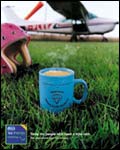
|
| Global market play: For people who need
adrenalin |
Business has a
certain Darwinian logic to it. A logic that kept Indian business
fearful of the Big Bad World overseas, where large corporations
with multi-billion dollar outlays could crunch anything of Indian
origin out of existence.
Well, here's some news. Sometimes, the small
get to swallow the big. On February 27, 2000, humble little homegrown
Tata Tea snapped up Tetley of UK, a company thrice its size, for
a tidy sum of £274 million (Rs 2,117.05 crore).
Says Homi R. Khusrokhan, Managing Director,
Tata Tea, "The acquisition of Tetley has catapulted Tata Tea
into the league of a new emerging breed of Indian Transnational
Companies who realise that, sooner rather than later, the world
has to be their marketplace."
It was a lot of money, and the deal involved
the setting up of a fully-owned special purpose vehicle (SPV) in
the UK-with £70 million (Rs 540.85 crore) of equity, and an
unbelievable £200 million-odd (Rs 1,545.3 crore) in debt.
Some analysts even think that the Tata group got carried away by
the glory of the moment, and overpaid (rival bids were lower). The
Tatas even had to inject an additional £30 million (Rs 231.8
crore) into the SPV in 2001.
But in pure factual terms-of an acquisition
made-it was certainly a winning moment. The largest cross-border
acquisition made by an Indian company, ever. And a move that turned
Tata Tea into a global marketer of tea overnight, and the world's
No. 2, after Unilever. In one shot, Tata Tea's consolidated turnover
stands at Rs 3,073 crore for 2001-02.
Moreover, the company not only has access to
a global market (that Tetley addresses), but also a global tea-leaf
procurement system perfected over the years and a vast portfolio
of innovative products, including dripless teabags, herbal teas
and flavoured teas (with flavours as exotic as black currant, strawberry,
apple and cinnamon). The challenge now is to show that Indian marketing
minds are as good as any, in addressing the bewildering diversities
of the world.
To be sure, Tata Tea's move hasn't sent Unilever
into a cold sweat. Tata is at best a distant contender for global
leadership. Its worldwide marketshare stands at around 4 per cent,
against Unilever's 10 per cent. But the company has an aggressive
plan to shake up the tea business worldwide, and stack up the volumes.
But developing markets overseas, or even shifting them in any significant
way to favour the company, can cost huge sums of money.
The big question is whether the Tata group
has the resources to play a global game. The outcome of this test
case could determine how ambitious Indian companies want to be-as
global marketers.
2001
Lagaan Takes Bollywood Abroad
Lagaan's overseas run could mark the
beginning of Bollywood's grab for global eyeballs.
 |
| The Lagaan XI: Oscar or not,
the Ashutosh Gowarikar movie succeeded in putting Bollywood
on the global map |
What would be the
winning moment for this one? The day- March 24, 2001-that Ashutosh
Gowarikar's cricket tale 'Lagaan' was nominated for the Best Foreign
Film award at the Oscars? The Friday it opened to packed theatres
in India? Or the moment the audience erupted at the cinematic climax?
A bloodless Indian victory. Against impossible odds (11 clueless
dhoti-clad villagers, against 11 accomplished Anglo-Saxons). And
do-or-die stakes (thrice the tax on losing, no tax on winning).
The nail-chewing went all the way to la, for
an Oscar. Alas, Bollywood couldn't pull off a last-minute stunt
this time round. Oscar or no Oscar, what the Lagaan victory symbolises
is Bollywood's ambition to go global, and play on the same celluloid
field as Hollywood. For the same eyeballs. If a rustic fantasy could
impress American critics, and even draw some $2 million (Rs 9.6
crore) at the US and UK box offices, why not other films?
"A nation is poor when it stops dreaming,"
says Mahesh Bhatt, film-maker, "and Lagaan has rekindled dreams."
The Indian film industry actually sells more tickets than the American
industry (3.6 billion, to 2.6 billion), but its value realisation
remains pathetically low. Targeting the world market could change
all that. The Indian market is estimated at only $850 million (Rs
4,096 crore), while the world market is placed at over $50 billion
(Rs 24,09,500 crore). Convergence won't be easy, though.
To enchant global audiences with its unique
idiom, Bollywood will have to retain its local essence while adapting
itself to the pulse of la. The watchword will be universalisation.
|

